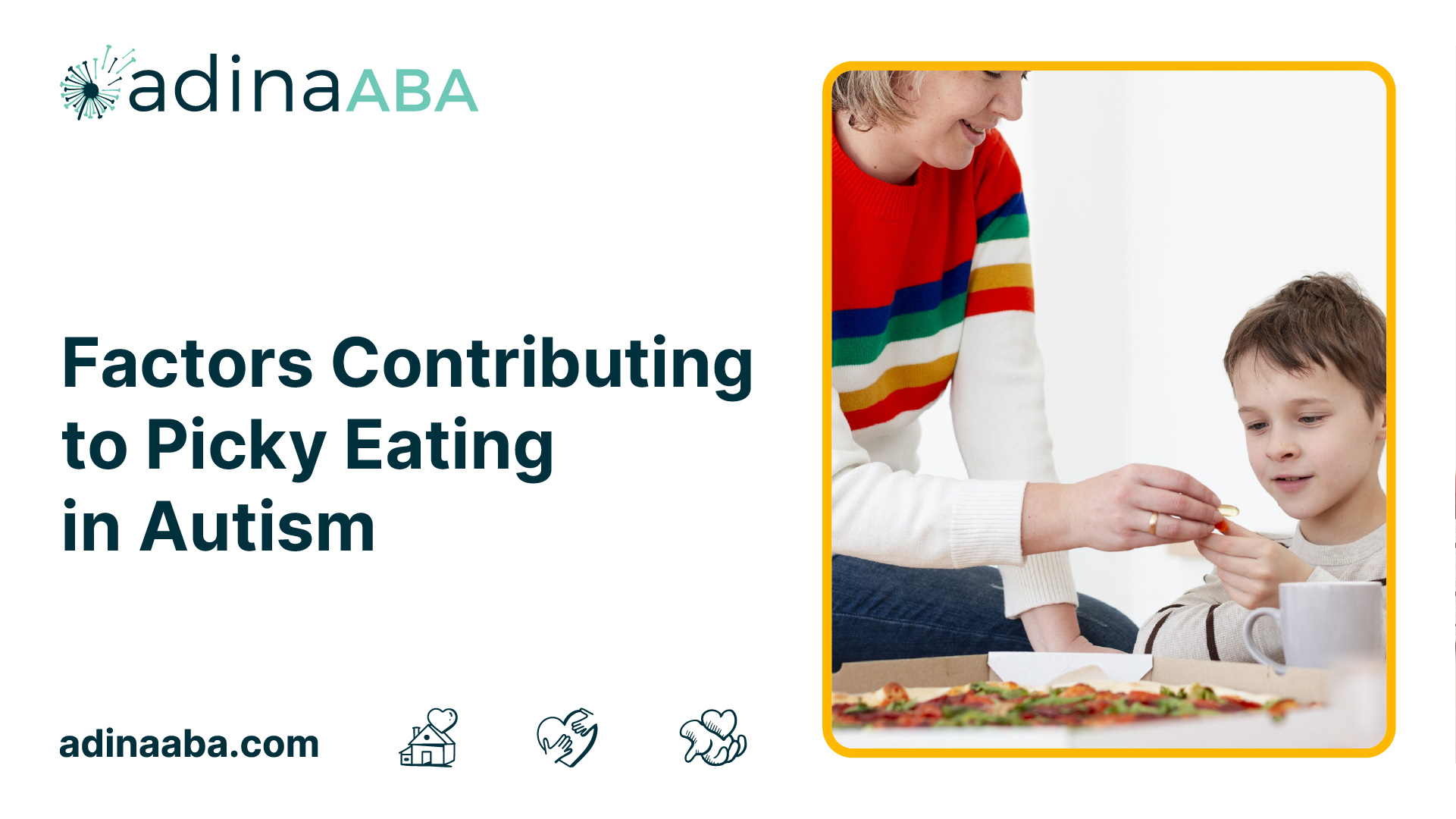The Best Practices on Overcoming Autism and Picky Eating Challenges
.jpg)

Understanding Picky Eating in Autism
When it comes to individuals with autism, picky eating can be a common challenge. Understanding the nature of picky eating in autism is essential for providing appropriate support. In this section, we will explore the definition of picky eating and the prevalence of this issue within the autism community.
Defining Picky Eating
Picky eating, also known as selective eating or food neophobia, refers to the consistent refusal or avoidance of certain foods or food groups. Individuals who are picky eaters often have a limited range of preferred foods and may exhibit strong aversions to unfamiliar or new foods. They may also be sensitive to certain textures, tastes, or smells, which can further contribute to their selective eating habits.
For individuals with autism, picky eating can manifest in various ways. Some may have a strong preference for specific foods with limited nutritional value, while others may completely avoid entire food groups. The underlying reasons behind picky eating in autism can be complex and multifaceted, involving sensory sensitivities, limited food preferences, and the need for routine and structure.
Prevalence of Picky Eating in Autism
Picky eating is highly prevalent among individuals with autism. Research studies have consistently shown that individuals on the autism spectrum are more likely to exhibit selective eating behaviors compared to their neurotypical peers. However, the severity and specific food aversions can vary greatly from person to person.
According to a study published in the Journal of Autism and Developmental Disorders, approximately 70-90% of children with autism experience some degree of picky eating. These eating difficulties can persist into adolescence and adulthood, affecting the individual's overall quality of life and nutritional status.
Understanding the prevalence of picky eating in autism highlights the importance of addressing this issue and providing appropriate support. By recognizing the unique challenges faced by individuals on the autism spectrum, we can work towards developing effective strategies to help them expand their food repertoire and improve their nutritional intake.
In the next section, we will explore the factors that contribute to picky eating in autism, shedding light on the underlying reasons behind this behavior and providing insights for managing and supporting individuals with autism and picky eating.
Factors Contributing to Picky Eating in Autism
Picky eating is a common challenge faced by individuals with autism. Several factors contribute to this behavior, including sensory sensitivities, limited food preferences, rigid routines and structure, and anxiety and control issues. Understanding these factors can help caregivers and professionals develop effective strategies to manage picky eating in individuals with autism.

Sensory Sensitivities
Sensory sensitivities play a significant role in picky eating among individuals with autism. Many autistic individuals have heightened or altered sensory perceptions, which can affect their experience of food. Certain textures, smells, tastes, or even the appearance of food can be overwhelming and aversive. These sensory sensitivities can lead to a limited acceptance of certain foods and a preference for familiar or preferred textures and flavors.
Limited Food Preferences
Limited food preferences are another factor contributing to picky eating in autism. Some individuals with autism may have a narrower range of acceptable foods compared to typically developing individuals. They may prefer specific food groups or have a limited variety of foods they are willing to eat. This can be due to sensory sensitivities, a resistance to change, or a need for predictability and routine.
Rigid Routine and Structure
The need for routine and structure is a common characteristic of autism. Individuals with autism often thrive on predictability and may struggle with changes to their established routines. This rigidity can extend to mealtime, where any deviation from their preferred foods or eating patterns can cause distress. The insistence on sameness and resistance to trying new foods can contribute to picky eating behaviors.
Anxiety and Control Issues
Anxiety and control issues are also factors that contribute to picky eating in individuals with autism. Many autistic individuals experience heightened anxiety, particularly in unfamiliar situations or when faced with new foods. This anxiety can manifest as a need for control over their environment, including what they eat. Picky eating behaviors can serve as a way for individuals to exert control over their food choices and reduce anxiety.
Understanding these factors is crucial in developing effective strategies for managing picky eating in individuals with autism. By addressing sensory sensitivities, expanding food preferences through gradual exposure, creating a positive mealtime environment, and seeking professional support when needed, caregivers and professionals can support individuals with autism in developing a more varied and balanced diet. For more information on overcoming food aversions in autism, check out their article on overcoming food aversions in autism.
Impact of Picky Eating on Individuals with Autism
Picky eating in individuals with autism can have various impacts on their overall well-being. Understanding these impacts is crucial in order to provide appropriate support and interventions. Let's explore the nutritional concerns, social challenges, and impact on daily living and independence associated with picky eating in autism.

Nutritional Concerns
Picky eating in autism can lead to significant nutritional concerns. Individuals with autism often have limited food preferences and may avoid entire food groups, resulting in an imbalanced diet. This can lead to deficiencies in essential nutrients, vitamins, and minerals. Nutritional concerns may include inadequate intake of protein, fruits, vegetables, and fiber.
Ensuring a balanced and nutritious diet for individuals with autism is important for their overall health and well-being. Collaborating with a healthcare professional, such as a registered dietitian, can help develop a personalized meal plan that meets their nutritional needs.
Social Challenges
Picky eating in autism can also present significant social challenges. Mealtime can become a source of stress and frustration for both individuals with autism and their families. The limited food preferences and refusal to try new foods may lead to difficulties in social situations, such as family meals, school cafeterias, or social gatherings.
These social challenges can impact the individual's ability to participate fully in community activities and may lead to feelings of isolation. It is important to provide support, understanding, and acceptance to individuals with autism to help them navigate these social challenges. For more information on picky eating in autistic children, refer to their article on picky eating in autistic children.
Impact on Daily Living and Independence
Picky eating in autism can also impact daily living and independence. Individuals with autism who have limited food preferences may face difficulties when dining out, traveling, or attending events where food options are limited. This can restrict their participation in various activities and limit their independence.
The impact of picky eating on daily living can extend beyond mealtimes. It can affect the individual's ability to develop essential life skills, such as meal planning, grocery shopping, and cooking. This can hinder their overall independence and autonomy.
Supporting individuals with autism in expanding their food choices and developing a more varied diet can help improve their daily living skills and increase their independence.
By recognizing the impact of picky eating on individuals with autism, we can better understand their unique challenges and provide the necessary support and interventions. Collaborating with professionals and creating a positive mealtime environment can play a crucial role in helping individuals with autism overcome picky eating behaviors and lead healthier, more fulfilling lives.

Strategies for Managing Picky Eating in Autism
Managing picky eating in individuals with autism requires a tailored approach that takes into account their unique needs and challenges. Here are some strategies that can be helpful in addressing picky eating behaviors in individuals on the autism spectrum.

Sensory-Based Approaches
Sensory sensitivities are often associated with picky eating in autism. Some individuals may have aversions to certain textures, tastes, or smells, making it difficult for them to try new foods. Employing sensory-based approaches can help desensitize individuals and expand their food repertoire. These approaches may include:
- Food Play: Encouraging individuals to interact with new foods through sensory play, such as touching, smelling, or squishing them, can help reduce anxiety and increase familiarity.
- Food Exploration: Gradually introducing new foods in a non-threatening manner, by incorporating them into sensory play activities or presenting them alongside preferred foods, can help individuals become more comfortable with trying new foods.

Gradual Exposure and Food Chaining
Gradual exposure and food chaining techniques can be effective in expanding the variety of foods an individual with autism is willing to eat. These techniques involve introducing new foods in small increments, building upon familiar foods, and gradually incorporating new flavors, textures, or ingredients. By connecting new foods to already accepted ones, individuals can develop a greater tolerance for unfamiliar options.

Creating a Positive Mealtime Environment
Creating a positive mealtime environment is key to reducing anxiety and promoting a more relaxed atmosphere for individuals with autism. Consider the following strategies:
- Predictability: Establishing a consistent routine and structure during mealtimes can provide a sense of predictability, helping individuals feel more comfortable.
- Visual Supports: Using visual schedules or meal choice boards can enhance communication and comprehension, allowing individuals to have a better understanding of what to expect during mealtimes.
- Appropriate Seating: Ensuring individuals are seated in a comfortable and supportive chair can enhance their focus and engagement during meals.
- Family Style Meals: Encouraging family-style meals where everyone sits together and shares food can create a positive and inclusive atmosphere.
Seeking Professional Support
When dealing with picky eating in autism, seeking professional support can be invaluable. Consulting with a registered dietitian, speech-language pathologist, or occupational therapist who specializes in feeding difficulties can provide expert guidance and personalized strategies. These professionals can evaluate the specific challenges an individual is facing and develop a comprehensive plan to address picky eating behaviors.
Remember that each individual with autism is unique, and what works for one person may not work for another. It's important to approach picky eating with patience, empathy, and understanding. Celebrate small victories and celebrate progress, even if it's gradual. By implementing these strategies and seeking professional support, individuals with autism can develop a healthier relationship with food and expand their dietary choices.

Supporting Individuals with Autism and Picky Eating
Supporting individuals with autism who experience picky eating requires a compassionate and collaborative approach. By understanding their unique challenges and working together with professionals, we can help them navigate their picky eating habits and make progress. Celebrating small victories along the way can also provide encouragement and motivation. Here are some strategies to support individuals with autism and picky eating:

Empathy and Understanding
It is essential to approach individuals with autism and picky eating with empathy and understanding. Recognize that their food preferences and aversions may be influenced by sensory sensitivities, limited food preferences, routine and structure, and anxiety or control issues. By acknowledging their challenges and respecting their preferences, we can create a supportive environment that fosters trust and openness.
Collaboration with Professionals
Collaboration with professionals, such as pediatricians, dietitians, and occupational therapists, can be invaluable in managing picky eating in individuals with autism. These professionals can provide expert guidance, personalized strategies, and support tailored to the specific needs of the individual. Working together as a team can help address nutritional concerns, develop appropriate meal plans, and implement effective interventions.

Celebrating Small Victories
When supporting individuals with autism and picky eating, it's essential to celebrate small victories along the way. Recognize and acknowledge their progress, no matter how small it may seem. This positive reinforcement can boost their confidence and motivation to continue exploring new foods and expanding their preferences. By focusing on the positive aspects of their journey, we can create a positive and encouraging mealtime environment.
By approaching individuals with autism and picky eating with empathy, collaborating with professionals, and celebrating small victories, we can provide the support and encouragement needed for them to navigate their picky eating habits. Remember, every step forward is a step in the right direction.
FAQs
Is picky eating in autism a sign of a larger problem?
While picky eating is common among children with autism, it is not necessarily a sign of a larger problem. However, it is important to monitor your child's nutrition and make sure they are getting the necessary nutrients for their growth and development.
Will my child outgrow their picky eating habits?
It is possible for children with autism to expand their food preferences over time. However, some children may continue to have limited food preferences throughout their lives. Working with a registered dietitian can help ensure that your child is getting the necessary nutrients despite their limited food choices.
Should I force my child to eat new foods?
It is important to respect your child's food preferences and avoid forcing them to eat new foods. Instead, focus on offering a variety of foods at each meal and gradually introducing new textures and flavors in a way that is comfortable for your child.
What if my child only eats a few select foods?
If your child has an extremely limited range of food preferences, it may be helpful to work with a feeding therapist or occupational therapist who specializes in sensory issues related to eating. They can offer strategies for expanding your child's food choices in a way that is comfortable for them.
Are there any supplements or vitamins that can help improve my child's nutrition?
It is best to consult with a registered dietitian or healthcare provider before giving your child any supplements or vitamins. While some supplements may be helpful for certain nutritional deficiencies, it is important to ensure that you are giving your child the appropriate dosage and form of the supplement.
Conclusion
Picky eating can be a frustrating issue for children with autism and their caregivers. However, with patience and persistence, it is possible to expand a child's food preferences and improve their nutrition. By working with a registered dietitian, offering a variety of foods, using visual aids, and trying food chaining, you can help your child overcome their picky eating habits and develop a healthier relationship with food.
Sources
https://tacanow.org/picky-eating-and-autism
https://childmind.org/autism-and-picky-eating
https://www.henryford.com/autism-and-picky-eating
https://www.thetreetop.com/aba-therapy/autism-and-picky-eating
https://beaminghealth.com/autism-and-picky-eating-what-parents-should-know
More Resources
Expert Clinicians
Get started today ->






.jpg)